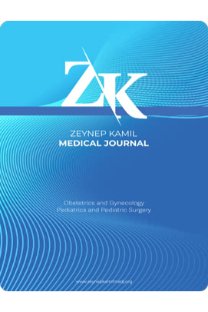Febril konvülziyonda serum çinko düzeyleri
Serum zinc levels in febrile convulsions
___
- 1.Verity CM. Do seizures damage the brain? The epidemiological evidence. Arch Dis Child 1998;78:78-84
- 2.American Academy of Pediatrics. Practice parameter: Long-term treatment of the child with simple febrile seizures(AC9859). Pediatrics 1999;103:1307-9
- 3.Yakut A. Febril Konvülziyon. 47. Milli Pediatri Kongresi Özet Kitabı 2003.s 53-7
- 4.Beisel WR, Pekarek RS, Van Ormer D, Wannemacher RW. Influence of acute infection on the metabolism of zinc and other trace elements
- Psychopharmacol Bull 1971:7:34-35
- 5.Izumi Y, Ishii K, Akiba K, Hayashi T
- Hypozincemia during fever may trigger febrile convulsions. Med Hypotheses 1990:32:77-80
- 6.Gündüz Z, Kumandaş S,Yavuz 1, Koparal M, Saraymen R. Serum and cerebrospinal fluid zinc levels in febrile convulsions. Turk J Med Res 1994:12:239-42
- 7.Gündüz Z, Yavuz İ, Koparal M, Kumandaş S, Saraymen R. Serum and cerebrospinal fluid zinc levels in children with febrile convulsions. Ada Paediatr Jpn 1996;38:237-41
- 8.Tütüncüoğlu S, Kütükçüler N, Kepe L, Çöker C, Berdeli A, Tekgül H. Proinflammdtory cytokines, prostaglandins and zinc in febrile convulsions
- Pediatr Int 2001:43:235-9
- 9.Burhanoğlu M, Tütüncüoğlu S, Coker C, Tekgül "Çük Kafalı" teriminin nereden tü H, Özgür T. Hypozincaemia in febrile convulsion
- Eur J Pediatr. 1996:155:498-50
- 10.Mollah MA, Dey PR, Tarfdar SA et al. Zinc in CSF of patients with febrile convulsion. Indian J Pediatr.2002;69:859-61
- 11.Garty BZ, Olomucki R, Sagie TL, Nitzan M
- Cerebrospinal fluid zinc concentrations in.febrile convulsions. Arch Dis Child 1995;73:338-41
- 12.Brown KH, Peerson JM, Rivera J, Allen LH. Effect of suplemental zinc on the growth and serum zinc concentrations of prepubertal children: a meta analysis of randomized controlled trials. Am J Clin Nutr 2002)75:1062-71.
- ISSN: 1300-7971
- Yayın Aralığı: 4
- Başlangıç: 1969
- Yayıncı: Ali Cangül
Case report: Isolated tubal torsion combined with contralateral tubal ectopic pregnancy
PINAR KUMRU, Gültekin KÖSE, Nurettin AKA, Tuzcular Zeynep VURAL, Selvinaz ÖZKARA
Beta-ketothiolaz eksikliği: Olgu sunumu
Öznur KILIÇ, Serdar CÖMERT, Gülay Çiler ERDAĞ, YASEMİN AKIN, Semiramis SADIKOĞLU, Ayça VİTRİNEL
Febril konvülziyonda serum çinko düzeyleri
Rabia Gönül SEZER, Özahi İlke İPEK, Abdülkadir BOZAYKUT, ENVER ATAY, Olcay ÜNVER
Tayfun KUTLU, Elif BAĞLAM, Zeynep GENÇ, Y. Sadiye EREN
Jüvenil dermatomitozitli bir olgu sunumu
Tuba GİRAY, Özlem CANTÜRK, Turgut AĞZIKURU, Gülay Çiler ERDAĞ, Neslihan ÇİÇEK, YASEMİN AKIN, Ayça VİTRİNEL
Prekonsepsiyonel dönemdeki kadınların değerlendirilmesi
HEDİYE ARSLAN ÖZKAN, ASİBE ÖZKAN
Ertan ADALI, Recep YILDIZHAN, Begüm YILDIZHAN, Necdet SÜER
Serviksin glassy hücreli karsinomu
Gözde KIR, Handan ÇETİNER, Sadiye EREN, Ateş KARATEKE
İleri evre over kanserini taklit eden tüberküloz peritonit vakaları: Olgu sunumu
Ayşe GÜRBÜZ, Ateş KARATEKE, Canan KABACA, Elçin ÇETİNGÖZ, Karsel ERTEKİN
Raloksifen Hcl tedavisinin koaglasyon profiline etkisi
Deniz KÖSE, Hüsamettin USLU, Özay ORAL, Semih TUĞRUL, Akif ALKAN, Arzu AYDIN
